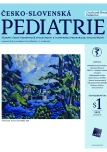Summer-associated dermatitides in children
Authors:
Uherová Jana
Authors‘ workplace:
Oddělení dermatologie pro děti Fakultní nemocnice v Motole, Praha
Published in:
Čes-slov Pediat 2022; 77 (Supplementum 1): 38-45.
Category:
Review
doi:
https://doi.org/10.55095/CSPediatrie2022/029
Overview
This article provides a summary of the most common summer-associated dermatitides. Atopic eczema represents the most prevalent skin disorder in pediatric dermatology clinic. However, during the summer period the cases of atopic eczema are often replaced by other dermatitides which are typical for the summer period. The increase of summer-associated dermatitides is driven mostly by often stay in nature and by traveling. Except of prevalent Lyme disease, the summer-associated dermatitides are mostly preventable diseases with mild course and spontaneous recovery. However, they can cause unpleasant summer time of children.
Keywords:
Lyme disease – miliaria – sunburn – immunologically mediated photodermatoses – photophytodermatitis – henna – cercarial dermatitis – whirlpool dermatitis – sting of cnidarians – insect bites – strophulus infantum – trombiculosis
Sources
1. Paller AS, Mancini AJ. Hurwitz clinical pediatric dermatology: a textbook of skin disorders of childhood and adolescence. 5th ed. Philadelphia: Elsevier– Saunders 2016.
2. Torbahn G, Hofmann H, Rucker G, et al. Efficacy and safety of antibiotic therapy in early cutaneous lyme borreliosis: a network meta-analysis. JAMA Dermatol 2018; 154(11): 1292–1303.
3. Krbová L, Kybicová K, Pícha D, et al. Doporučený postup diagnostiky a léčby lymeské borreliózy. Klin Mikrobiol Inf Lék 2018; 24(3): 88–99.
4. Schachner LA, Andriessen A, Benjamin LT , et al. Do antimicrobial resistance patterns matter? An algorithm for the treatment of patients with impetigo. J Drugs Dermatol 2021; 20(2): 134–142.
5. Wenzel FG, Horn TD. Nonneoplastic disorders of the eccrine glands. J Am Acad Dermatol 1998; 38(1): 1–17/quiz 8–20.
6. Passeron T, Lim HW, Goh CL, et al. Photoprotection according to skin phototype and dermatoses: practical recommendations from an expert panel. J Eur Acad Dermatol Venereol 2021; 35(7): 1460–1469.
7. Balk SJ, Council on Environmental H, Section on D. Ultraviolet radiation: a hazard to children and adolescents. Pediatrics 2011; 127(3): e791–817.
8. Krajsová I. Fotoprotekce u dětí. Pediatr Praxi 2012; 13(3): 204–205.
9. Quatrano NA, Dinulos JG. Current principles of sunscreen use in children. Curr Opin Pediatr 2013; 25(1): 122–129.
10. Polášková S. Celoroční péče o dětskou pokožku. Dermatol Praxi 2012; 6(2): 68–72.
11. Kadurina M, Kazandjieva J, Bocheva G. Immunopathogenesis and management of polymorphic light eruption. Dermatol Ther 2021; 34(6): e15167.
12. Ferguson J. Diagnosis and treatment of the common idiopathic photodermatoses. Australas J Dermatol 2003; 44(2): 90–96.
13. Nitiyarom R, Wongpraparut C. Hydroa vacciniforme and solar urticaria. Dermatol Clin 2014; 32(3): 345–53, viii.
14. Ross G, Foley P, Baker C. Actinic prurigo. Photodermatol Photoimmunol Photomed 2008; 24(5): 272–275.
15. Hojyo-Tomoka T, Vega-Memije E, Granados J, et al. Actinic prurigo: an update. Int J Dermatol 1995; 34(6): 380–384.
16. Chandrasekar PH, Rolston KV, Kannangara DW, et al. Hot tub-associated dermatitis due to Pseudomonas aeruginosa. Case report and review of the literature. Arch Dermatol 1984; 120(10): 1337–1340.
17. Feder jr HM, Grant-Kels JM, Tilton RC. Pseudomonas whirlpool dermatitis. Report of an outbreak in two families. Clin Pediatr (Phila) 1983; 22(9): 638–642.
18. Čapková S. Dětské dermatózy v letním období. Pediatr Praxi 2010; 11(3): 150–153.
19. Shimizu M, Matsuoka S, Ando K. Cercaria dermatitis. J Dermatol 1981; 8(2): 117–124.
20. Freudenthal AR, Joseph PR. Seabather’s eruption. N Engl J Med 1993; 329(8): 542–544.
21. Pereira JCC, Szpilman D, Haddad jr V. Anaphylactic reaction/angioedema associated with jellyfish sting. Rev Soc Bras Med Trop 2018; 51(1): 115–117.
22. Li L, McGee RG, Isbister G, Webster AC. Interventions for the symptoms and signs resulting from jellyfish stings. Cochrane Database Syst Rev 2013(12): CD009688.
23. Carlsen K, Weismann K. Phytophotodermatitis in 19 children admitted to hospital and their differential diagnoses: Child abuse and herpes simplex virus infection. J Am Acad Dermatol 2007; 57(5 Suppl): S88–91.
24. Pfurtscheller K, Trop M. Phototoxic plant burns: report of a case and review of topical wound treatment in children. Pediatr Dermatol 2014; 31(6): e156–59.
25. Strouhalová I, Drlík L. Fytofotodermatitidy. Čes slov Derm 2014; 89(6): 225–262.
26. Yang X, Yu L. Textual research on henna art introduced into ancient China through the Silk Road. Asian Social Science 2020; 16(9): 21.
27. Foti C, Balato N, Cristaudo A, et al. Multicenter clinical trial on a permanent hair dye containing paratoluenediamine. G Ital Dermatol Venereol 2018; 153(4): 464–468.
28. Panfili E, Esposito S, Di Cara G. Temporary black henna tattoos and sensitization to para-Phenylenediamine (PPD): two paediatric case reports and a review of the literature. Int J Environ Res Public Health 2017; 14(4): 421.
29. Schmiedbergerová R, Šebková M, Vojáčková N. Kontaktní ekzém po tetováži henou. Čes slov Derm 2008; 83(1): 25–29.
30. de Groot AC. Side-effects of henna and semi-permanent ‚black henna‘ tattoos: a full review. Contact Dermatitis 2013; 69(1): 1–25.
31. Kamath S, Kenner-Bell B. Infestations, bites, and insect repellents. Pediatr Ann 2020; 49(3): e124–e31.
32. Yavuz ST, Akin O, Koc O, et al. Mosquito hypersensitivity may be associated with atopic background in children. Allergol Immunopathol (Madr) 2021; 49(6): 67–72.
33. Caputo V, Santi F, Cascio A, et al. Trombiculiasis: an underreported ectoparasitosis in Sicily. Infez Med 2018; 26(1): 77–80.
34. Potts J. Eradication of ectoparasites in children. How to treat infestations of lice, scabies, and chiggers. Postgrad Med 2001; 110(1): 57–59, 63–64.
35. Sood SK. Lyme disease in children. Infect Dis Clin North Am 2015; 29(2): 281–294.
Labels
Neonatology Paediatrics General practitioner for children and adolescentsArticle was published in
Czech-Slovak Pediatrics

2022 Issue Supplementum 1
- What Effect Can Be Expected from Limosilactobacillus reuteri in Mucositis and Peri-Implantitis?
- The Importance of Limosilactobacillus reuteri in Administration to Diabetics with Gingivitis
Most read in this issue
- Summer-associated dermatitides in children
- Tick-borne encephalitis in Slovakia – epidemiology and history
- Tick-borne infections in the conditions of the Czech Republic
- Drowning
